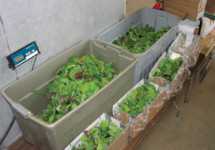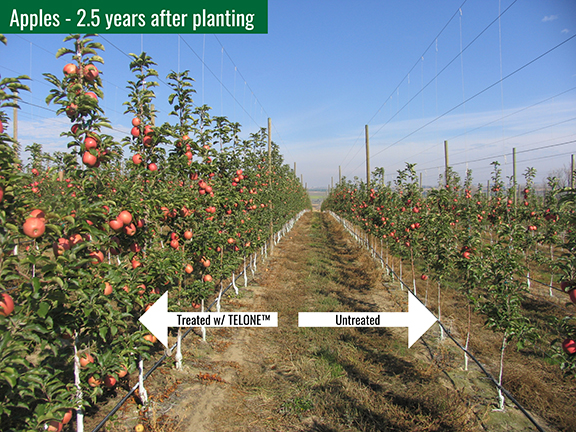Learning The Ropes Of Organic Vegetable Growing

Our adventure into vegetable growing began in 1995, when my wife and I purchased a 50-acre farm in rural Bedford County, PA. Initially, it was a conventional operation, but after a little more than a year, we learned about a group called TOG or Tuscarora Organic Growers. TOG is a cooperative interested in finding organic growers producing specific commodities.
It was then that we decided to go the organic route with our farm, Shoestring Acres. Originally, only 1.5 acres was eligible to be certified, but as we became more comfortable and enthusiastic with the philosophy, the transition process began, and by 2000 all of our ground was certified organic.
Off To A Good Start
Like many growers, the production process begins in the greenhouse. We have two greenhouses, one with continual heat and one that is basically a cold frame with only enough heat to prevent a late-winter freeze.
A soil-based growing system is used for leafy greens such as kales, chards, mustards, and several specialty greens. French tarragon is grown in several permanent beds in the greenhouse as the weather grows warmer.
We also make sure there is space to grow transplants for the outdoor season, and a small area of the greenhouse is set aside for seed trials. To keep the plants healthy, fertility is strictly mineral based, as no manures are used in the greenhouse. Foliar fish fertilizer is used with the transplants only.
Disease pressure in the greenhouse is nearly always related to high humidity or to tight row spacing of the plants. Drying things out by running the fans or thinning will usually take care of the problem. Fungicidal products have never been used in the greenhouse.
All pests are managed via natural predators and insecticidal sprays that are compatible with organic growing. We have found that, in many cases, natural predators can control the problem. Lacewings, lady beetles, parasitic wasps, and praying mantis have all been released at one point or another during our tenure. In fact, praying mantis egg masses are glued throughout our greenhouse.
The insecticidal sprays sometimes used are Pyganic (pyrethrin, McLaughlin Gormely King), Bacillus thuringiensis (Bt), insecticidal soap, and neem oil. Determining if any of these measures needs to be used depends on the level of pests present. Over the years, aphids have been the major pest in the greenhouse. Buyers really don’t care for the added protein they provide.
Battling Pests Outside
In the field, the one insect pest that has been a thorn in my side with vine crops is the cucumber beetle. Zucchini, for example, is a favorite of theirs. Early transplants need to be protected as soon as possible. A major application of rotenone is done when plants are small. I use a back-pack duster to apply the material as soon as the pests are observed. Once the vines approach the edge of the plastic, I discontinue the rotenone and switch to Pyganic.
I rarely need to apply anything for tomato insect pests. For pepper crops, however, a Bt is used to deal with some of the worms that cause damage. Cole crops attract the cabbage worm and loopers. Bt is again the tool of choice to deal with these pests.
Aphids are not only a problem in the greenhouse, they also cause problems in broccoli fields. Pyganic and insecticidal soap are used to keep them in check. Even with the abundant presence of predators, this is one crop that eventually seems to fall to aphids if the problem is not addressed when the pest is first noted in the field.
The best tool to use, however, is diligent scouting. I believe growers need to walk their fields and observe what is happening.
Controlling Disease And Weeds
Controls also are available to the organic grower to combat fungal pressure in the field. On tomatoes, copper and Oxidate (hydrogen peroxide, Biosafe Systems) are used fairly regularly. These two controls are both OMRI listed (Organic Materials Review Institute). Fall zucchini and squash also get this treatment to combat powdery mildew, which is present every season, later in the season.
To control weeds, timely cultivation has turned out to be the best method of control, especially between the rows of plastic. For instance, I time the last cultivation between the vine crops so the canopy will provide adequate shade to deter excessive weed growth. On occasion, I do use a propane torch for small areas. I have found, however, that using a propane torch isn’t a good idea after applying mulch to the asparagus, especially following a dry spell.
The Big Picture
I have observed one notable difference since going to an organic system: the proliferation of natural predators. While listening to experts discuss pest control during educational sessions at conferences, I heard many discussions on what pesticides to use on peppers for conventional control of aphids. This situation was portrayed as a significant problem. Today, unlike the situation with broccoli, I rarely observe aphids on peppers, and we do more than 5,000 pepper plants a year. I believe the natural predators are responsible.
As I close, I will share a conversation I had with an inspector many years ago. It dealt with a grower who lost a large number of melon acres to disease. I recall him reflecting that this loss was just one of the risks of farming the “organic” way.
That comment did not sit well with me, as I was struggling financially as it was. But, as time has passed, I have learned that by taking a full circle approach to managing our farm — rotating crops, growing good varieties, making sure soils are well-balanced, and using safe and effective products — these catastrophic losses can be minimized or eliminated and a quality product can be grown.









